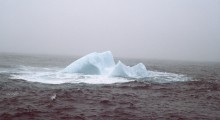Icebergs are a natural and beautiful part of Earth's cryosphere, and are closely monitored and studied by scientists around the world. We asked JPL research scientists Ben Holt and Michael Schodlok to attempt to remove some of the mystery shrouding these floating flotillas of ice.
You are here
News
UAVSAR conducted the first San Andreas Fault monitoring flight in the San Francisco Bay area, together with Hayward Fault, on April 13. During the flight, DGPS FM3 worked well with the new Navcom receiver firmware. On April 16, the Slumgullion landslide in Colorado were imaged and additional flight lines for San Andreas Fault monitoring. Two additional San Andreas Fault monitoring flights are scheduled for the remainder of the week.
The ESTO IIP-07 task “Panchromatic Fourier Transform Spectrometer (PanFTS) for the Geostationary Coastal and Air Pollution Events (GEO-CAPE) Mission”, led by PI Stan Sander at JPL, has recently completed the one-year accelerated life testing on the optical path difference mechanism (OPDM). The primary function of the OPDM is to translate the moving mirror element of the Michelson interferometer. The two most important OPDM performance characteristics are to keep the moving mirror perpendicular to the optical beam by the OPDM’s piezo-actuated tip/tilt stage, and to smoothly translate the mirror with minimal jitter.
During the 12-month long accelerated life test, the OPDM was cycled more than 2.6 million times over its full range of travel (0 mm to 50 mm) in hard vacuum at -100° C. This set of test parameters and duration was to demonstrate an equivalence of 5 years of space operation. After the test, the ability of the tip/tilt stage to keep the mirror aligned remained unchanged, and the translation stability of the OPDM continued to be excellent and was well below the 1% design requirement.
The ESTO IIP-07 task “Panchromatic Fourier Transform Spectrometer (PanFTS) for the Geostationary Coastal and Air Pollution Events (GEO-CAPE) Mission”, led by PI Stan Sander at JPL, has recently completed the one-year accelerated life testing on the optical path difference mechanism (OPDM). The primary function of the OPDM is to translate the moving mirror element of the Michelson interferometer. The two most important OPDM performance characteristics are to keep the moving mirror perpendicular to the optical beam by the OPDM’s piezo-actuated tip/tilt stage, and to smoothly translate the mirror with minimal jitter. During the 12-month long accelerated life test, the OPDM was cycled more than 2.6 million times over its full range of travel (0 mm to 50 mm) in hard vacuum at -100° C. This set of test parameters and duration was to demonstrate an equivalence of 5 years of space operation. After the test, the ability of the tip/tilt stage to keep the mirror aligned remained unchanged, and the translation stability of the OPDM continued to be excellent and was well below the 1% design requirement.
As of February 16, the Airborne Dual-Frequency Precipitation Radar (APR-2) has completed 9 science flights as part of the Global Precipitation Mission (GPM) Cold Season PrecipitationExperiment (GCPEx). It flies on the NASA DC-8 aircraft out of Bangor, Maine; the GCPEx flights have been coordinated with ground instrumentation in Canada and with other aircrafts. APR-2 has collected high quality data over isolated snow showers, widespread, light snow, and heavier lake-effect snow, as well as cold rain during these flights. The APR-2 data will be used to simulate data for the GPM mission, allowing development and testing of radar rainfall retrieval algorithms for the GPM’s dual-frequency radar, which has the same frequencies and geometry as APR-2.
Press release by Dryden on "NASA Science Aircraft to travel the globe in 2012" features UAVSAR amongst other airborne missions to be conducted this year.
Geologists have a new tool to study how earthquakes change the landscape, and it's giving them insight into how earthquake faults behave. In the Feb. 10 issue of the journal Science, a team of scientists from the United States, Mexico and China, including geophysicist Eric Fielding of NASA's Jet Propulsion Laboratory, Pasadena, Calif., reports the most comprehensive before-and-after picture yet of an earthquake zone, using data from the magnitude 7.2 event that struck near Mexicali, northern Mexico in April 2010.
CARVE PI (Chip Miller) and PM (Steve Dinardo) traveled to Wallops flight facility to meet with the C-23 flight and safety engineer. We worked out details for CARVE equipment placement on the C-23, and schedule for the upcoming CARVE C-23 deployment to Alaska.
Last week, CARVE sponsored the CARVE 2012 Science Team meeting on January 10 and 11, here at JPL. The team displayed and discussed 28 presentations. The meeting was very successful and informative. All CARVE 2012 science meeting presentations have been uploaded to the CARVE docushare site. The FTS was shipped from Quebec to JPL. The FTS was reviewed by JPL on Tuesday 1/17/2012.
A new sea surface temperature (SST) dataset from the WindSat radiometer on the Coriolis satellite in now available from the JPL PO.DAAC. This radiometer senses in the microwave spectrum and is thus relatively immune to clouds similar to the now defunct AMSR-E instrument on the NASA Aqua platform. The spatial resolution is 0.25 degrees with a twice daily temporal resolution. In the data processing chain, a near-real-time (NRT) dataset (identified with a "rt" within the file name) is made as available as soon as possible. A subsequent final dataset (identified by "v7" within the file name) is produced later and contains more observations than the NRT version. These data are produced by Remote Sensing Systems in support of the Group for High Resolution Sea Surface Temperature (GHRSST) Project. Although it is called "L2P Gridded" it is actually Level 3 (a grid).



